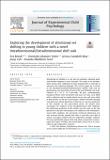Files in this item
Exploring the development of attentional set shifting in young children with a novel Intradimensional/Extradimensional shift task
Item metadata
| dc.contributor.author | Reindl, Eva | |
| dc.contributor.author | Völter, Christoph Johannes | |
| dc.contributor.author | Campbell-May, Jessica | |
| dc.contributor.author | Call, Josep | |
| dc.contributor.author | Seed, Amanda Madeleine | |
| dc.date.accessioned | 2022-06-14T09:41:09Z | |
| dc.date.available | 2022-06-14T09:41:09Z | |
| dc.date.issued | 2022-09 | |
| dc.identifier | 279304937 | |
| dc.identifier | 74250107-64d1-43e9-848c-63a2b17fd7d2 | |
| dc.identifier | 000794965900002 | |
| dc.identifier | 85129055352 | |
| dc.identifier.citation | Reindl , E , Völter , C J , Campbell-May , J , Call , J & Seed , A M 2022 , ' Exploring the development of attentional set shifting in young children with a novel Intradimensional/Extradimensional shift task ' , Journal of Experimental Child Psychology , vol. 221 , 105428 . https://doi.org/10.1016/j.jecp.2022.105428 | en |
| dc.identifier.issn | 0022-0965 | |
| dc.identifier.other | RIS: urn:1D9A0FE42B85D903DB56363BBF515C00 | |
| dc.identifier.other | ORCID: /0000-0002-3867-3003/work/112333108 | |
| dc.identifier.other | ORCID: /0000-0002-8597-8336/work/112333775 | |
| dc.identifier.uri | https://hdl.handle.net/10023/25523 | |
| dc.description | The research of A.M.S. was supported by an “INQMINDS” European Research Council (ERC) Starting Grant (SEP-210159400). | en |
| dc.description.abstract | Attentional set shifting is a core part of cognition, allowing quick and flexible adaption to new demands. The study of its development during early childhood has been hampered by a shortage of measures not requiring language. This article argues for a revival of the Intradimensional/Extradimensional (ID/ED) shift task by presenting a new nonverbal version of the task (Shifting Tray task). Children (N = 95 3- to 5-year-olds; 49 girls; predominantly European White) were presented with pairs of trays, each filled with a substrate and an upside-down cup on top, and were asked to find stickers. In the pre-switch phase, children learned (through trial and error) which dimension (substrate or cup) was predictive of the rewards. In the post-switch phase, all stimuli were exchanged. For children in the intradimensional shift condition, the dimension predictive of the sticker was the same as the one predictive in the pre-switch phase. For children in the extradimensional shift condition, the previously irrelevant dimension was now relevant. Results showed that most 3-year-olds were able to switch, and older children did not outperform younger children. The easy and flexible nature of the task allows researchers to investigate the impact of labels and instructions and to use it in cross-cultural and comparative research. | |
| dc.format.extent | 19 | |
| dc.format.extent | 848258 | |
| dc.language.iso | eng | |
| dc.relation.ispartof | Journal of Experimental Child Psychology | en |
| dc.subject | Cognitive flexibility | en |
| dc.subject | Attentional set shifting | en |
| dc.subject | Attention shifting | en |
| dc.subject | Executive functions | en |
| dc.subject | Intradimensional/Extradimensional shift | en |
| dc.subject | Cognitive development | en |
| dc.subject | BF Psychology | en |
| dc.subject | NDAS | en |
| dc.subject | AC | en |
| dc.subject.lcc | BF | en |
| dc.title | Exploring the development of attentional set shifting in young children with a novel Intradimensional/Extradimensional shift task | en |
| dc.type | Journal article | en |
| dc.contributor.sponsor | European Research Council | en |
| dc.contributor.institution | University of St Andrews. School of Psychology and Neuroscience | en |
| dc.contributor.institution | University of St Andrews. Institute of Behavioural and Neural Sciences | en |
| dc.contributor.institution | University of St Andrews. Centre for Social Learning & Cognitive Evolution | en |
| dc.contributor.institution | University of St Andrews. ‘Living Links to Human Evolution’ Research Centre | en |
| dc.identifier.doi | 10.1016/j.jecp.2022.105428 | |
| dc.description.status | Peer reviewed | en |
| dc.identifier.grantnumber | 639072 | en |
This item appears in the following Collection(s)
Items in the St Andrews Research Repository are protected by copyright, with all rights reserved, unless otherwise indicated.

